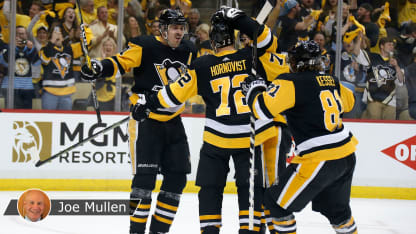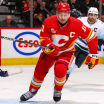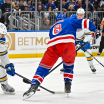Power play proving to be big playoff weapon
Mullen says more movement key with man-advantage

In this 2018 Stanley Cup Playoffs edition, Joe Mullen, a former assistant with the Pittsburgh Penguins and Philadelphia Flyers and 2000 player inductee into the Hockey Hall of Fame, analyzes why the power plays have been so effective in this postseason.
All eight teams competing in the second round of the Stanley Cup Playoffs have been excelling on the power play.
The Vegas Golden Knights (17.9 percent) are the lone team among the eight whose power play is clicking at less than 20 percent. The Boston Bruins lead the way at 36.7 percent followed by the Washington Capitals (31.6 percent), Tampa Bay Lightning (25.7 percent), Winnipeg Jets (25.0 percent), San Jose Sharks (24.4 percent), Nashville Predators (21.9 percent) and Pittsburgh Penguins (21.1 percent).
And the Golden Knights have been doing better against the Sharks in the Western Conference Second Round, going 6-for-27 (22.2 percent) on the power play through five games after going 1-for-12 (8.3 percent) against the Los Angeles Kings' excellent penalty kill in the first round.
If you're at 20 percent or higher, you've got a pretty good power play going.
Last season, three teams in the final eight operated at better than 20 percent for the playoffs: the Capitals (25.0 percent), the Edmonton Oilers (21.4 percent) and the Stanley Cup champion Penguins (20.5 percent).
In the past, it seemed like the penalty-killers always stepped up in the playoffs; not that they haven't this year, but the power plays have been doing the right things. They're moving the puck quickly and hitting the open guys. There's a lot of movement on the power plays these days, and they're making plays and executing.
It's about executing on your plays and moving the puck quick so that you get the open lanes to shoot the puck and get it to the net. So many teams block shots nowadays. All of these penalty-killing units clog up the middle, so it's a little bit harder to get the puck to the net.
When you're moving the puck up high in the offensive zone and the penalty kill overloads high, teams are getting the puck down low quickly and attacking low or vice versa. When you're working the puck low and the penalty kill overloads down low, then you get it up high, move it quickly and you should be able to find the open ice and get a shot.
As a coach, it always seemed the penalty-killers were ahead of the power plays in the playoffs because teams are able to plan to specifically take away what the power play does well. For example, it appears the Penguins have been trying to take away Alex Ovechkin on the power play, dropping a guy down with him on the left side and forcing the other guys to step up and beat them.
The Capitals have been able to do that so far. Jakub Vrana scored a power-play goal for Washington in Game 2, John Carlson scored one in Game 3 and T.J. Oshie scored one in Game 4.
Ovechkin has yet to score a power-play goal in the series after scoring three in the Eastern Conference First Round against the Columbus Blue Jackets, but Washington is 3-for-11 (27.3 percent) through four games against Pittsburgh.
Pittsburgh's power play has looked a lot better since Evgeni Malkin returned in Game 3 from a lower-body injury. After not scoring in the first two games without Malkin, it's gone 3-for-8 in the past two games, including Jake Guentzel's empty-net goal late in Game 4.
Malkin adds so much. He carries the puck in a lot. He's got that one-timer from the right circle, which is dangerous, so if the penalty kill overplays that, he can make the pass to somebody.
The five guys on the Capitals' first power play are as good as any: Ovechkin, Carlson, Oshie, Nicklas Backstrom and Evgeny Kuznetsov. The Penguins are the same way with Malkin, Justin Schultz, Sidney Crosby, Phil Kessel and Patric Hornqvist on their first unit.
The Predators power play is also fun to watch. They have a talented group with P.K. Subban, Filip Forsberg, Ryan Johansen, Viktor Arvidsson and Craig Smith. All of them can shoot.
Every top unit has pretty much the same thing. And for the most part, every team uses the same 1-3-1 power-play formation. But every team has its own tweak here and there.
Boston is a little bit different. The Bruins move in and out well and switch well. Their players are all over the place. I like the way they do it.
You can find defenseman Torey Krug up top at the point, you can find him down low. He moves around quite a bit.
Movement causes problems because once you get set up, the penalty-killers would like to stand still and clog up the middle. But when you've got people switching and moving, now the penalty-killers are looking over their shoulders.
Krug should be up top, right? But maybe not. Now he's somewhere else.
It's usually a switch, but you've got to keep your eyes on everybody.
The Bruins also can put Rick Nash in front of the net with his big body (6-foot-4, 211 pounds) and his great hands and that reach that he has. That's a bonus, because it takes away the goalie's eyes.

















